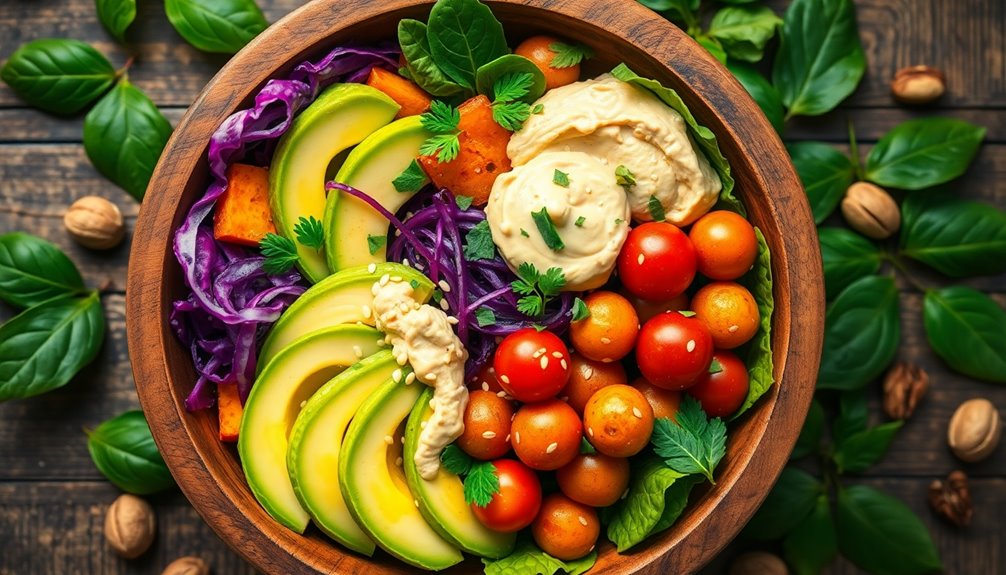Building a vegan Buddha bowl starts with choosing a nourishing base like quinoa or brown rice. Then, layer in delicious plant-based proteins such as tofu or chickpeas for texture. Fresh vegetables add color and nutrients—think mixed greens and seasonal produce. Don't forget healthy fats like avocado or a drizzle of tahini for flavor and nutrient absorption. Enhance your bowl with crunchy toppings like nuts or roasted chickpeas and finish it off with a tangy dressing to bring everything together. Each bowl is a chance to express creativity and balance. Continue exploring these elements to master your Buddha bowl creations.
Key Takeaways
- Start with a nutritious base like quinoa, brown rice, or farro to create a solid foundation for your Buddha bowl.
- Add a variety of plant-based proteins such as legumes, tofu, or tempeh to enhance texture and nutritional value.
- Incorporate a colorful assortment of fresh vegetables and leafy greens to boost visual appeal and health benefits.
- Drizzle with flavorful dressings or sauces, like tahini or miso, to elevate the taste and enjoyment of your bowl.
- Finish with toppings like avocado, roasted chickpeas, and nuts for added texture and flavor, creating a satisfying meal experience.
Understanding Buddha Bowls
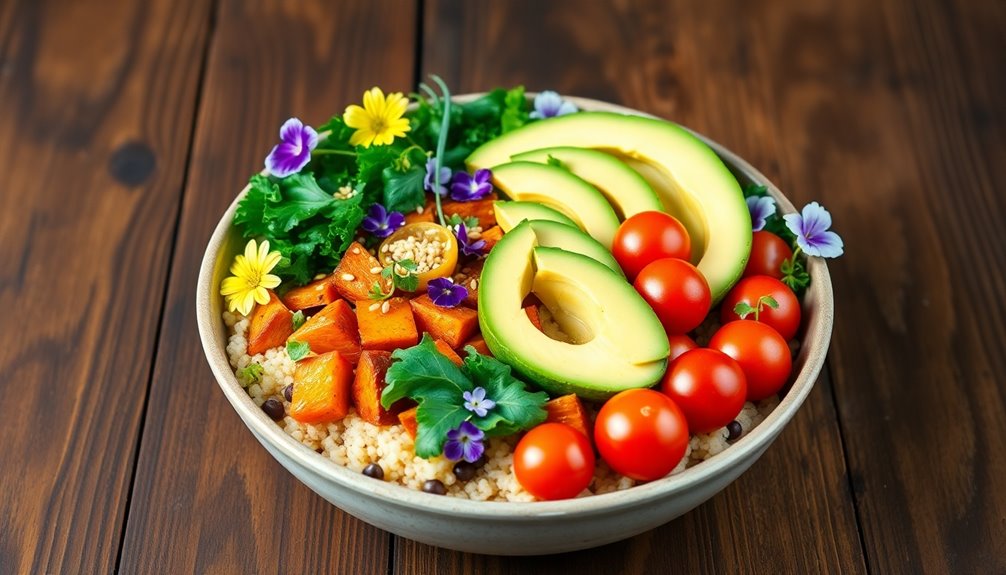
Understanding Buddha bowls starts with recognizing their vibrant, nourishing nature. These bowls are more than just a meal; they're a canvas for balanced nutrition and a celebration of creativity. Picture a colorful assortment of fresh vegetables, hearty grains, and protein-packed legumes artfully arranged in a single dish. Each ingredient contributes not only to the flavor but also to the visual appeal, inviting you to immerse yourself.
When you build a Buddha bowl, you're embracing the art of creative presentation. Layering colorful ingredients showcases your personal style, turning a simple meal into a feast for the eyes. Think of vivid greens, bright oranges, and deep purples, all working together to create a visually stunning dish. This aesthetic doesn't just elevate your dining experience; it fosters a sense of belonging as you share your creations with friends or family.
Moreover, Buddha bowls offer a way to explore diverse flavor profiles while ensuring balanced nutrition. You can mix and match ingredients to cater to your taste preferences, dietary needs, and seasonal availability. Whether you're fueling up for a busy day or winding down in the evening, these bowls can adapt to your lifestyle.
Ultimately, understanding Buddha bowls means appreciating their role in nourishing both body and soul. They encourage you to connect with food, cultivate creativity, and share delightful experiences with others, making every meal an opportunity for joy and togetherness.
Choosing the Right Base
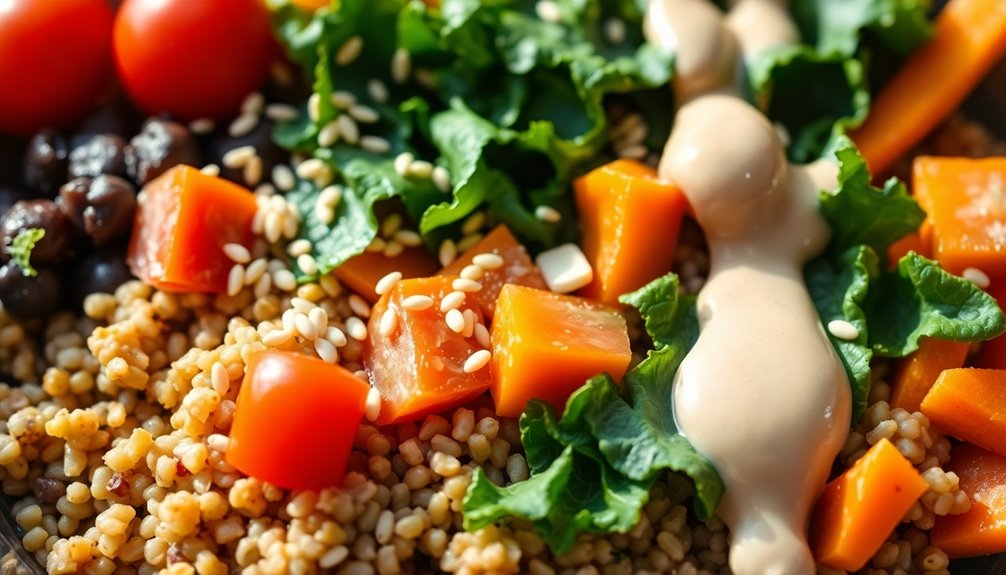
When it comes to assembling the perfect Buddha bowl, selecting the appropriate base sets the groundwork for a tasty and fulfilling meal. Think of your base as the canvas for a vibrant masterpiece, uniting various flavors and textures. The right grain choices not only establish a robust foundation but also boost the overall nutrition of your bowl.
Commence with popular grains such as quinoa, brown rice, or farro. Quinoa delivers a protein-packed kick, while brown rice offers a chewy texture and earthy taste. If you're seeking something a tad different, consider farro for its nutty flavor and satisfying crunch. You could even explore gluten-free alternatives like millet or buckwheat to accommodate dietary preferences.
Once you've selected your grain, the real excitement begins with the colorful pairings you can concoct. Layer vibrant veggies like roasted sweet potatoes, sautéed kale, or fresh cherry tomatoes over your base. Add some shredded carrots or crispy radishes for extra texture. Remember the greens! A handful of spinach or arugula can liven up your bowl and supply vital nutrients.
As you mix and match, keep in mind that the aim is to craft a bowl that's not only nourishing but also visually enticing. Your taste buds will appreciate you as you immerse yourself in a delightful array of flavors, all stemming from that ideal base. So, embrace the possibilities and let your creativity shine!
Selecting Protein Options
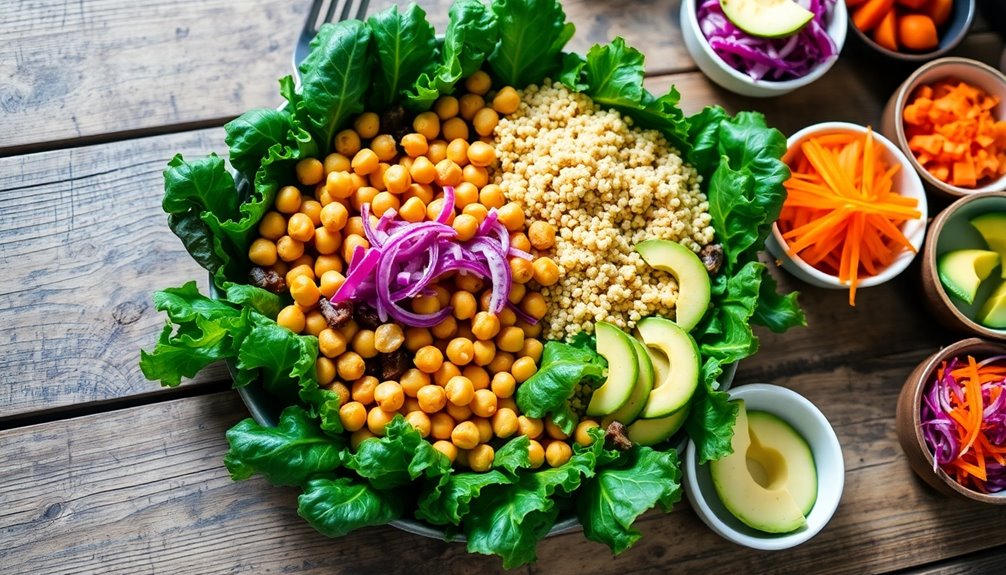
To create a truly satisfying Buddha bowl, you'll want to prioritize protein options that not only enhance flavor but also provide essential nutrients. Choosing the right protein sources is key to achieving a nutritional balance in your meal. As a vegan, you've got plenty of delicious and nutritious choices at your disposal.
Consider incorporating legumes like chickpeas, black beans, or lentils. They're not just packed with protein; they also add a delightful texture and earthy flavor to your bowl.
If you're looking for something with a bit of a crunch, roasted edamame or hemp seeds can elevate your dish while providing that satisfying protein boost.
Tofu and tempeh are fantastic options too. Tofu is incredibly versatile; you can marinate and grill it for a smoky flavor or crumble it for a texture similar to scrambled eggs. Tempeh, with its nutty taste, can be sautéed or crumbled into your bowl for a hearty addition.
Don't forget about quinoa! This complete protein source is perfect for adding both substance and a nutty flavor to your Buddha bowl.
Adding Fresh Vegetables
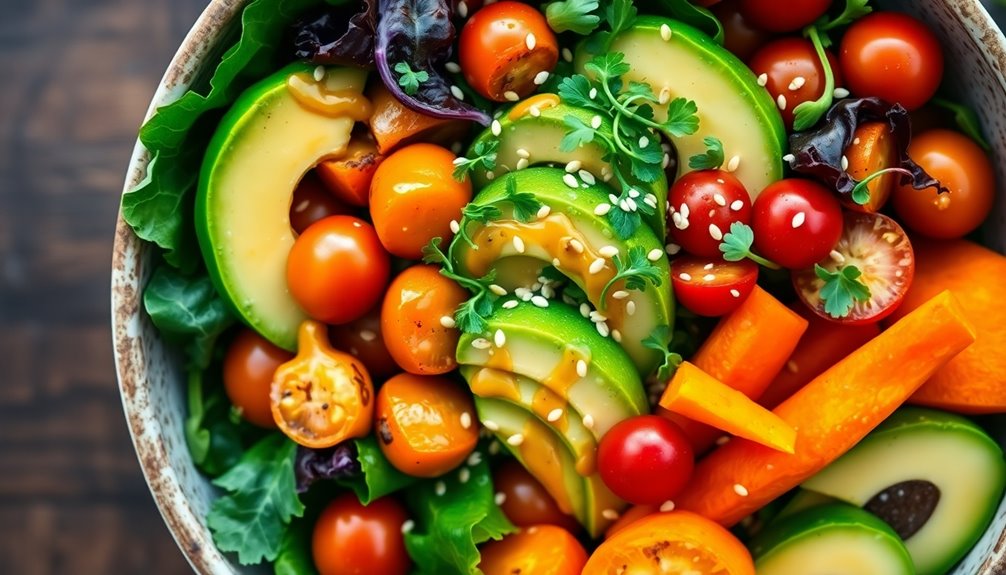
Incorporating crisp vegetables into your Buddha bowl not only enhances its visual appeal but also boosts its nutritional value. Imagine vibrant greens, luscious reds, and sunny yellows creating a feast for the eyes, inviting you to savor each bite. Start by choosing a veggie variety that speaks to you. Leafy greens like spinach or kale provide a nutrient-dense base, while crunchy bell peppers and radishes add a satisfying texture.
Don't shy away from colorful combinations! Mix in some roasted sweet potatoes for warmth, or toss in raw zucchini ribbons for an invigorating crunch. Think about seasonal vegetables, too; they bring freshness and flavor that can transform your bowl. Cherry tomatoes burst with juiciness, while shredded carrots add a sweet crunch.
Consider adding some herbs like cilantro or parsley for an aromatic touch that elevates your dish. You can also experiment with pickled vegetables, which introduce a tangy zest that can brighten up the entire bowl.
When you layer these crisp vegetables, you're not just creating a visually stunning meal; you're also fueling your body with essential vitamins and minerals. Embrace the joy of assembling your Buddha bowl, knowing that each colorful ingredient contributes to a healthy, satisfying experience.
Incorporating Healthy Fats
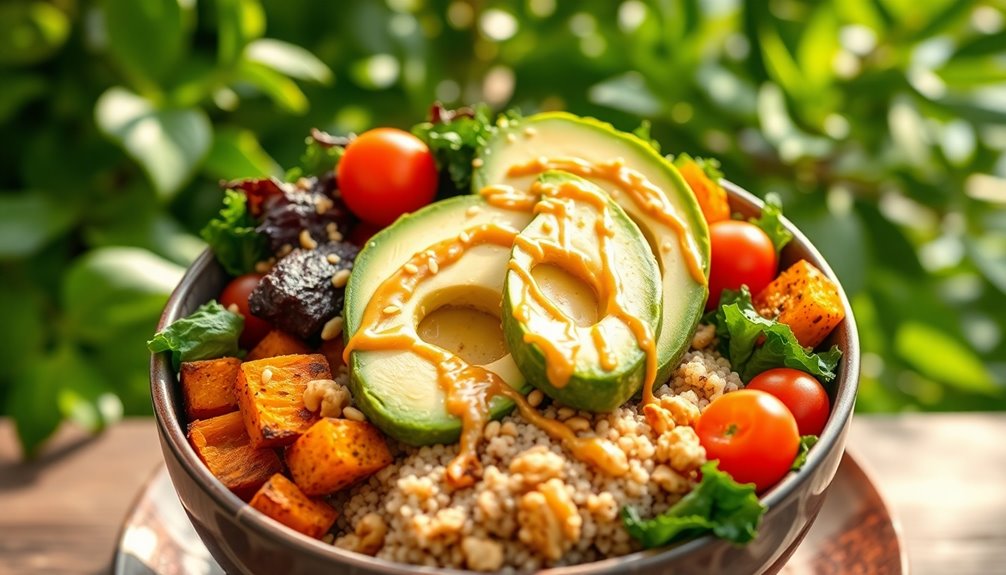
Adding healthy fats to your Buddha bowl can take your meal to the next level, both in flavor and nutrition. Healthy fats not only enhance the taste but also help your body absorb essential vitamins from the veggies you include.
One of the best sources of healthy fats is avocado. The avocado benefits are plenty—it's packed with monounsaturated fats that promote heart health and provide a creamy texture that makes your bowl feel indulgent. Just imagine slicing a ripe avocado and letting its rich, buttery flavor meld with your other ingredients.
Another great way to incorporate healthy fats is through nutritional oils. Drizzling a bit of olive oil or flaxseed oil over your Buddha bowl not only adds a lovely depth of flavor but also boosts your omega-3 fatty acid intake. These oils are fantastic for reducing inflammation and supporting brain health. Plus, they can elevate the overall visual appeal of your bowl, making it even more inviting.
Don't hesitate to experiment with other options like tahini or hemp seeds. These plant-based fats can add unique flavors and textures, enriching your meal experience.
Flavorful Toppings and Add-Ins
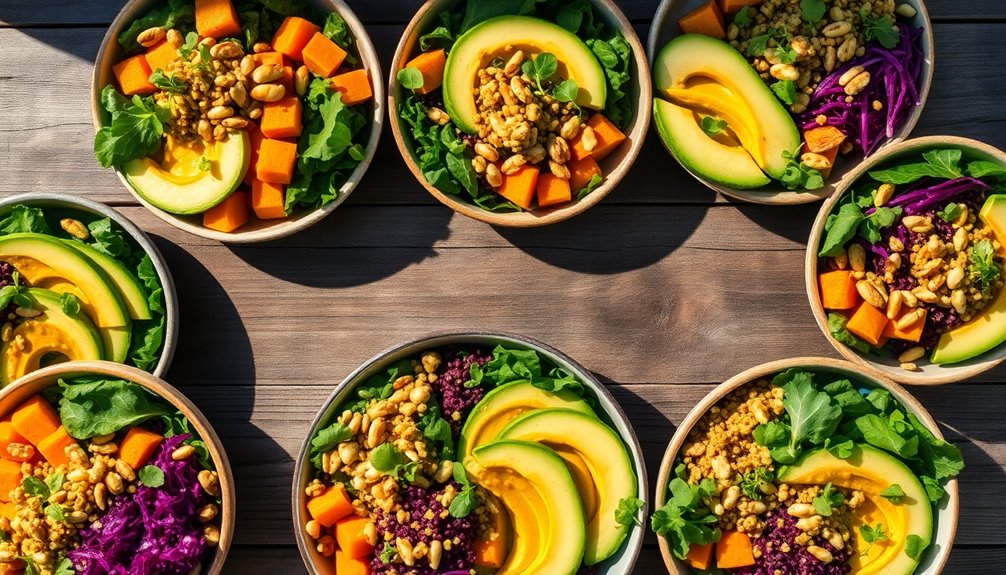
A colorful array of flavorful toppings and add-ins can transform your Buddha bowl into a culinary masterpiece. When you think about toppings, let your imagination run wild! You can create unique combinations that not only tantalize your taste buds but also elevate the visual appeal of your meal.
Picture vibrant cherry tomatoes, deep green avocado slices, and fiery red radishes, each contributing to a stunning palette that invites you to dig in.
Don't hold back on the textures, either. Crunchy roasted chickpeas or toasted pumpkin seeds can add a delightful contrast to your creamy bases. Fresh herbs like cilantro or basil can introduce a burst of freshness, while pickled vegetables bring an irresistible tang.
Consider adding some seasonal fruits, like juicy mango or sweet pomegranate seeds, for a surprising twist that enhances both flavor and colorful presentation.
You might also explore grains and legumes as add-ins. Quinoa, farro, or black beans not only provide additional nutrients but also create a satisfying heartiness. Mixing in a variety of toppings allows you to customize your bowl to your liking, so feel free to experiment until you find your perfect blend.
The beauty of Buddha bowls lies in their versatility—each creation can reflect your personality and preferences. So, gather your favorite ingredients and let your creativity shine through every colorful layer! You'll discover that the journey of building a Buddha bowl is just as rewarding as the meal itself.
Dressings and Sauces
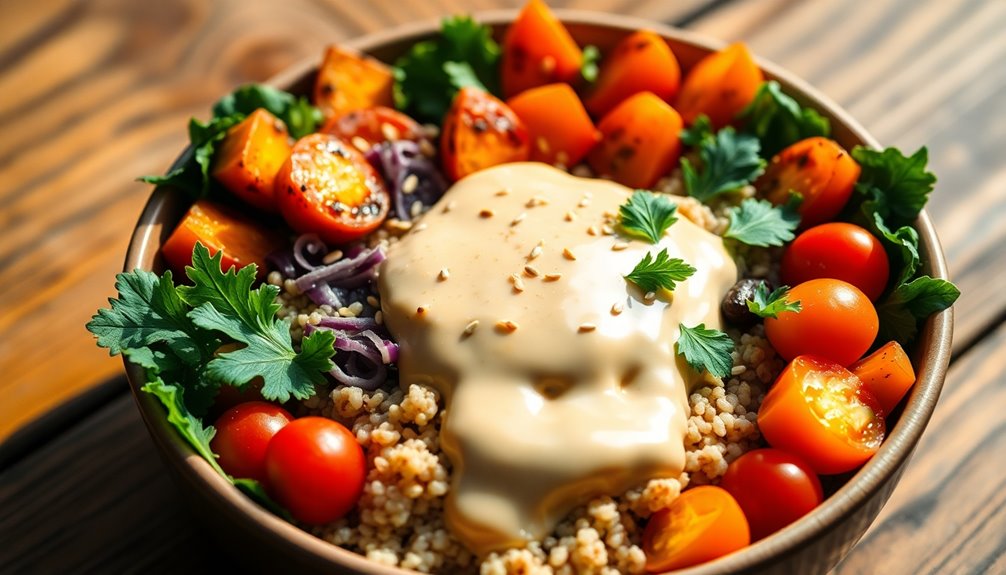
There's nothing like a delicious dressing or sauce to elevate your Buddha bowl, transforming it from simple to sensational. The right dressing not only ties all your ingredients together but also adds depth and excitement to every bite. Start with flavorful vinaigrettes that dance on your taste buds—think a bright lemon-tahini blend or an herb-infused balsamic. These add a invigorating zing that complements your veggies and grains beautifully.
If you're craving something richer, a creamy tahini sauce can be your go-to. This nutty delight drizzles over roasted veggies and greens, bringing a luxurious texture that comforts your soul. Simply whisk tahini with lemon juice, garlic, and water for a smooth consistency that's downright addictive.
For those who enjoy a bit of umami, consider incorporating tangy miso into your repertoire. A miso-based dressing adds a savory punch, perfect for drizzling over sautéed mushrooms or steamed broccoli. Just mix miso paste with a splash of rice vinegar and a touch of maple syrup for a sweet-savory balance.
And let's not forget zesty chimichurri. This vibrant sauce, packed with fresh herbs and garlic, brings boldness to any bowl. It works wonders over chickpeas or quinoa, transforming your meal into a culinary adventure.
With these dressings and sauces, you'll create a Buddha bowl that's not just a meal but an experience, inviting everyone to gather around and savor each flavorful bite together.
Frequently Asked Questions
Can I Prepare Buddha Bowls in Advance for Meal Prep?
Yes, you can definitely prepare Buddha bowls in advance for meal prep! The benefits of meal prepping include saving time and ensuring you've got healthy options on hand. To make it easy, batch-cook your grains and roast your veggies. Store your components separately to keep everything fresh. When you're ready to eat, just assemble and enjoy. This way, you'll always have a delicious, nutritious meal waiting for you, making healthy eating a breeze!
Are There Gluten-Free Options for Buddha Bowls?
Imagine a vibrant bowl filled with colorful veggies, grains, and proteins, all dancing together in harmony.
You can absolutely create gluten-free options for your Buddha bowls! Just swap in gluten-free grains like quinoa or brown rice, and be mindful of allergy considerations when selecting sauces and toppings.
With a sprinkle of fresh herbs and a dash of your favorite spices, you'll craft a delicious meal that everyone can enjoy, feeling included and satisfied.
How Do I Store Leftover Buddha Bowl Ingredients?
To store leftover Buddha bowl ingredients, you'll want to focus on food preservation and leftover management. Divide your ingredients into airtight containers to keep them fresh longer. Label each container with the date you stored them, and place them in the fridge.
For grains and beans, consider freezing portions for later use. This way, you can enjoy your delicious creations while minimizing waste and feeling connected to your culinary journey.
Can Children Enjoy Buddha Bowls?
Imagine colorful bowls brimming with vibrant veggies, crunchy grains, and tasty proteins—there's no reason kids can't enjoy these!
With kid-friendly variations, like adding sweet corn or avocado, you'll spark their interest while keeping meals fun. Just consider their nutritional needs; balance is key.
What Kitchen Tools Do I Need for Making Buddha Bowls?
To make delicious Buddha bowls, you'll need some essential utensils. Start with a sharp knife for chopping veggies and a cutting board for a stable prep area.
A pot or rice cooker is great for cooking grains, while a steamer basket works wonders for veggies.
Don't forget mixing bowls for combining ingredients! Mastering various cooking techniques like roasting, sautéing, or steaming will elevate your bowls, making them vibrant and full of flavor.
Happy cooking!
Conclusion
Incorporating vegan Buddha bowls into your meals not only nourishes your body but also supports a sustainable lifestyle. Did you know that adopting a plant-based diet can reduce your carbon footprint by up to 50%? As you explore the vibrant colors and textures of these bowls, remember you're making a delicious impact on the planet. So, gather your favorite ingredients, release your creativity, and enjoy a wholesome meal that's good for you and the Earth!

